= Harrisia pomanensis subs. bonplandii (J.Parm. & Pfeiff.) P.J.Braun & Esteves
Succulenta (Netherlands) 74: 131. 1995
Accepted Scientific Name: Harrisia pomanensis (F.A.C.Weber ex K.Schum.) Britton & Rose
Cactaceae (Britton & Rose) 2: 155, fig. 225. 1920 [9 Sep 1920] Britton & Rose
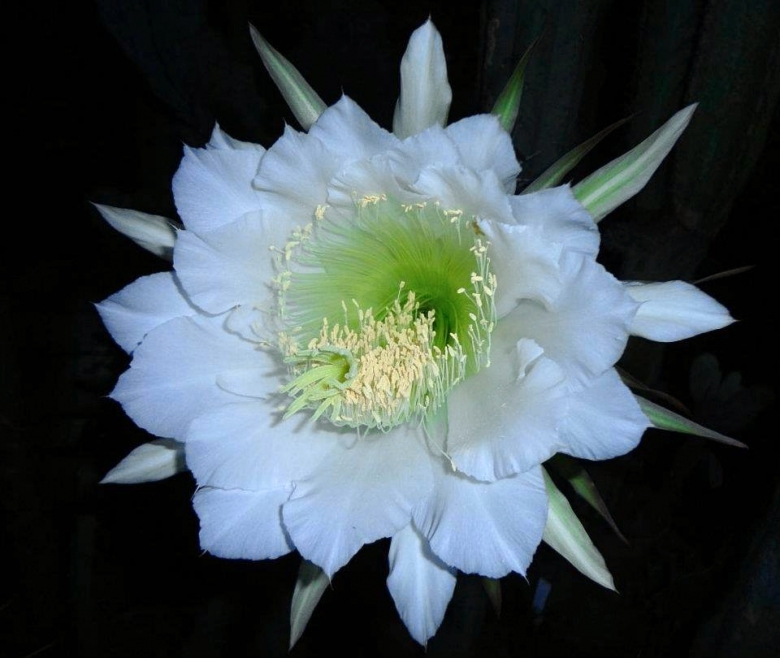
Harrisia bonplandii (Harrisia pomanensis subs. bonplandii) Photo by: Alexander Arzberger
Harrisia bonplandii has white nocturnal flowers and flowers easily. The flowers are large (up to 22 cm long), and close soon after sunrise.
Origin and Habitat: Harrisia pomanensisSN|8539]]SN|8539]] subs. bonplandii grows in the Gran Chaco (Paraguay, north of Argentina, Bolivia, and southwest of Brazil).
Habitat and ecology: Harrisia pomanensisSN|8539]]SN|8539]] subs. bonplandii is present in the understory at edges of dry forests, or associated with tropical plants. This terrestrial night-blooming cactus has escaped from cultivation and become naturalized in dry secondary thicket in many tropical countries.
Synonyms:
See all synonyms of Harrisia pomanensis
back
Accepted name in llifle Database:Harrisia pomanensis (F.A.C.Weber ex K.Schum.) Britton & RoseCactaceae (Britton & Rose) 2: 155, fig. 225. 1920 [9 Sep 1920]Synonymy: 11
Accepted name in llifle Database:Harrisia pomanensis subs. regelii (Weing.) R.KieslingDarwiniana 34(1–4): 395 (1996)Synonymy: 5
back
Common Names include:
ENGLISH: Applecactus, Midnight Lady, Queen of the Night
AYOREO (Morotoco, Ayoweo, Ayoré): Daturirai, Datura
ENLHET (Eenlhit): Laapang
NIVACLÉ (Chulupí and Ashluslay): Sôtôyuc
SPANISH (Español): Tuna, Reina de la Noche, Pasacana, Ulua, Ulúa
Description: The Midnight Lady (Harrisia pomanensisSN|8108]]SN|8539]] subs. bonplandii), is generally included within (as a synonym of) Harrisia pomanensisSN|8325]]SN|8539]], suggesting that there is not really a fundamental difference between the two and there remains a considerable confusion surrounding the true identity of this this plant. Up to 22 cm in length, the flowers are white with scales of the perianth-tube copiously woolly in the axils. The plant remains often unnoticed in the forest, but can not be overseen when it blossoms only in the night and where its Spanish name, Reina de la Noche (Queen of the Night) originates. This species is widely cultivated, but under different names, one of which is Cereus acutangulusSN|4346]]SN|4346]]. Fruits and roots are edible and well known to the native nations of the Gran Chaco.
Derivation of specific name. The name bonplandii honors the French scientific Aimé Bonpland.
Stems: Slender and weak, some erect or clambering and reaching 1–1.5 m, the other procumbent, arching or trailing on the ground up to 2.5-3 meters long, or, 3 to 8 cm in diameter, strongly (3-)4-angled. The margins are sharp and wavy.
Areoles: 2 cm apart.
Spines: 4-6 (or rarely more), acicular, the longest 0.5–2(-4) cm long, when young red and often black-tipped, in age grey. The single strong central spine (if present) is up to 2.5-3 centimetres long.
Flowers: White, nocturnal, funnelform,15 to 22(-25) cm long, closing soon after sunrise. Outer perianth segments green, pink-tipped. Pericarpel and corolla tube filled with large persistent scales copiously woolly in the axils. Filaments numerous, borne almost to the base of the tube. Style included; stigma-lobes numerous.
Fruit: Edible, globular, and strongly tuberculate, 4 to 6 cm in diameter, red, bearing large scales with hairs in their axils, spineless, splitting on the side and exposing the white flesh and black seeds.
Similar species: Harrisia bonplandiiSN|8551]]SN|8551]] differs from Harrisia martiniiSN|8539]]SN|8325]] by its areoles with 4–6 (not 1–3), much longer radial spines 5–20 mm long, and scales of the perianth tube woolly in the axils.
Note: It has been argued that this name should be rejected in favour of Harrisia balansaeSN|8539]]SN|8108]], but no formal proposal has been has been made, Hunt & al. (2006). Leuenberger (2001) wrote a detailed history of the name and recommended to maintain the use of H. bonplandii. Its modern application appears to be consistent and widely accepted.
Subspecies, varieties, forms and cultivars of plants belonging to the Harrisia pomanensis group
 Harrisia pomanensis (F.A.C.Weber ex K.Schum.) Britton & Rose: is a sprawling or clambering cactus to 3 m, sometimes somewhat shrubby. The flowers are white c. 15 cm long. Distribution: Argentina, Bolivia, and Paraguay.
Harrisia pomanensis (F.A.C.Weber ex K.Schum.) Britton & Rose: is a sprawling or clambering cactus to 3 m, sometimes somewhat shrubby. The flowers are white c. 15 cm long. Distribution: Argentina, Bolivia, and Paraguay. Harrisia pomanensis subs. bonplandii (J.Parm. & Pfeiff.) P.J.Braun & Esteves: same as Harrisia pomanensis, but flowers up to 22 cm in length, with scales of the perianth-tube copiously woolly in the axils. Distribution: Paraguay, Argentina, Bolivia, and Brazil.
Harrisia pomanensis subs. bonplandii (J.Parm. & Pfeiff.) P.J.Braun & Esteves: same as Harrisia pomanensis, but flowers up to 22 cm in length, with scales of the perianth-tube copiously woolly in the axils. Distribution: Paraguay, Argentina, Bolivia, and Brazil.- Harrisia pomanensis subs. regelii (Weing.) R.Kiesling: tends to be more shrubby, with smaller stems having fewer spines. Distribution: Argentina.
Notes: The widely grown Harrisia jusbertiiSN|8539]]SN|8195]] is considered by some to possibly be a natural intergenic hybrid betwee Harrisia pomanensisSN|8195]]SN|8539]], and Echinopsis eyriesiiSN|8004]]SN|8004]] rather than a pure species.
Bibliography: Major references and further lectures
1) Edward Anderson “The Cactus family” Timber Press, Incorporated, 2001
2) David R Hunt; Nigel P Taylor; Graham Charles; International Cactaceae Systematics Group. "The New Cactus Lexicon" dh books, 2006
3) James Cullen, Sabina G. Knees, H. Suzanne Cubey “The European Garden Flora Flowering Plants: A Manual for the Identification of Plants Cultivated in Europe, Both Out-of-Doors and Under Glass” Cambridge University Press, 11/Aug/2011
4) Oakley, L., Pin, A. & Duarte, W. 2013. “Harrisia pomanensis.” The IUCN Red List of Threatened Species. Version 2014.3. <www.iucnredlist.org>. Downloaded on 27 December 2014.
5) Karl J. Niklas “The Evolutionary Biology of Plants” University of Chicago Press, 08 giu 1997
6) N. L. Britton, J. N. Rose “The Cactaceae. Descriptions and Illustrations of Plants of the Cactus Family” volume 2 The Carnegie Institution of Washington, Washington f. 225 1920
7) Urs Eggli, Leonard E. Newton “Etymological Dictionary of Succulent Plant Names”. Springer, Berlin/Heidelberg 2010
8) Friesen Ratzlaff, Verena “Urunde´y - Schlorrekaktus - Pehen, Una guia para plantas leñosas del Chaco, Ein Feldführer für Chacogehölze” 2004.
9) Hunt, D.R., Taylor, N.P. & Charles, G. (eds.). "The New Cactus Lexicon". Milborne Port, England: dh Books. 2006.
10) Kiesling, R. "El genero Harrisia (Cactaceae) en La Argentina". Darwiniana 34: 389–398. 1996.
11) Leuenberger, B.E. "Harrisia bonplandii, case history of a controversial name in Cactaceae from South America." Bot. Jahrb. Syst. 123: 145–178. 2001.
12) Taylor, N.P. & Zappi “Cactaceae Consensus Initiatives”, 3: 7, as H. balansae.1997.
13) "Harrisia bonplandii." Wikispecies, . 11 Mar 2016, 07:06 UTC. 3 Jul 2016, 10:07 <https://species.wikimedia.org/w/index.php?title=Harrisia_bonplandii&oldid=2520208>.
14) Wikipedia contributors. "Harrisia bonplandii." Wikipedia, The Free Encyclopedia. Wikipedia, The Free Encyclopedia, 13 Feb. 2015. Web. 3 Jul. 2016.
15) David H. Lorence, Timothy W. Flynn, Warren L. Wagner “Contributions to the Flora of Hawai‘i. III New Additions, Range Extensions, and Rediscoveries of Flowering Plants” Harrisia bonplandii in: “Occasional Papers of Bernice Pauahi Bishop Museum: RECORDS OF THE HAWAII BIOLOGICAL SURVEY FOR 1994” Bishop Museum Press, 1984 NO. 41, p.28, 1995
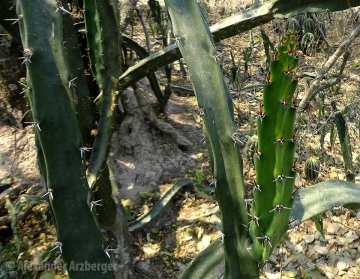 Harrisia bonplandii (Harrisia pomanensis subs. bonplandii) Photo by: Alexander Arzberger
Harrisia bonplandii (Harrisia pomanensis subs. bonplandii) Photo by: Alexander Arzberger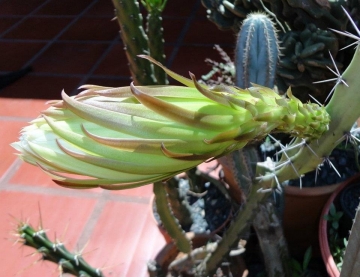 Harrisia bonplandii (Harrisia pomanensis subs. bonplandii) Photo by: Alexander Arzberger
Harrisia bonplandii (Harrisia pomanensis subs. bonplandii) Photo by: Alexander Arzberger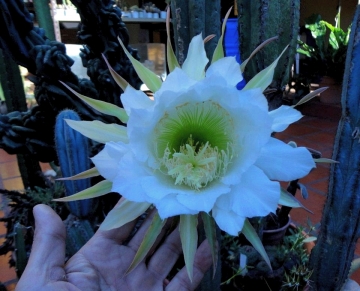 Harrisia bonplandii (Harrisia pomanensis subs. bonplandii) Photo by: Alexander Arzberger
Harrisia bonplandii (Harrisia pomanensis subs. bonplandii) Photo by: Alexander Arzberger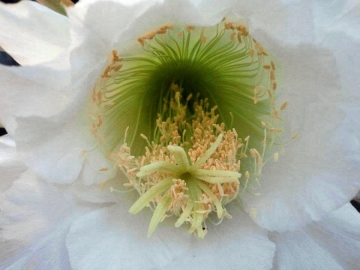 Harrisia bonplandii (Harrisia pomanensis subs. bonplandii) Photo by: Alexander Arzberger
Harrisia bonplandii (Harrisia pomanensis subs. bonplandii) Photo by: Alexander ArzbergerCultivation and Propagation: Harrisia pomanensis subs. bonplandii (Harrisia bonplandiiSN|8551]]SN|8551]]) presents no problems in cultivation and will do well in a sunny spot in a cactus house.
Soil: Grow them in rich, porous, sandy soil and let their soil dry out between waterings. If potted, repot in the spring if their roots become cramped. Generally, they should be repotted every other year in order to provide fresh soil. However, this doesn't necessarily mean they'll need larger containers. Fill about a quarter of the pot with broken crocks, gravel, etc. to promote good drainage. After repotting, do not water for a week or more.
Hardiness: These plants will not tolerate extended periods of frost; they can survive to a minimum temperature of -4°C.
Traditional uses: Fruits and roots are edible and well known to the native nations of the Gran Chaco. The fresh mature fruits and the boiled flowers are edible. The Maka natives also ate boiled or roasted roots. The Maka use the thorns to make tatoos.
Propagation: It can be increased by seeds or cuttings. Cuttings of healthy shoots can be taken in the spring and summer, Cut the stem with a sharp, sterile knife just above a bud or shoot (a 7-10cm long tip or branch is most suitable for propagation) Leave the cutting in a warm, dry place for a week or weeks (depending on how thick the cutting is) until a callus forms over the wound. Once the callus forms, the cutting may be inserted into a container filled with firmed cactus potting mix topped with a surface layer of coarse grit. They should be placed in the coarse grit only; this prevents the cut end from becoming too wet and allows the roots to penetrate the rich compost underneath. The cuttings should root in 2 to 6 weeks.
Garden uses: This species forms long columns that are great for grafting valuable species of cacti and - differently from other common grafting stock - don’t induces plants to elongate out of character and produce weak spination. The scions on Harrisia don’t grow as fast as the ones grafted on other tender and stronger stock, but they prosper very easy and can be kept in dark and cold places in winter. It can easily endure some light frost, too.















